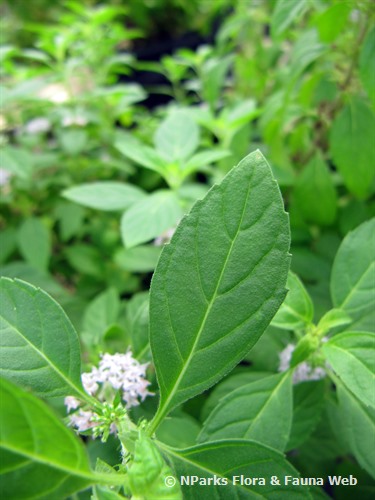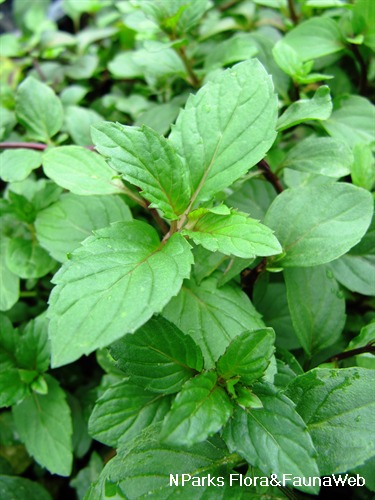
Back
Mentha arvensis L.
| Family Name: | Lamiaceae (Labiatae) |
| Common Name: | Corn Mint, European Corn Mint, Wild Mint, Field Mint, Japanese Peppermint, Tule Mint, Brook Mint, 野薄荷, 日本薄荷 |
Name
Classifications and Characteristics
| Plant Division | Angiosperms (Flowering Seed Plants) (Dicotyledon) |
|---|---|
| Plant Growth Form | Herbaceous Plant |
| Lifespan (in Singapore) | Perennial |
| Mode of Nutrition | Autotrophic |
| Maximum Height | 0.5 m to 1 m |
Biogeography
| Native Distribution | Europe to Siberia and Nepal |
|---|---|
| Native Habitat | Terrestrial (Temperate Forest, Riverine) |
| Preferred Climate Zone | Temperate |
Description and Ethnobotany
| Others - Plant Morphology | Growth Form: Herbaceous perennial that grows from a rhizome (underground horizontal stem). Habitat: Occurs on moist soil in meadows and near the edge of forests or streams.Foliage: Opposite arrangement of leaves (1.5 - 5 cm long). Leaves green and ovate or elliptic, having a serrate leaf margin. Flowers: Small, light purple or white flowers (0.3 – 0.6 cm long) occur in whorls (1 – 2 cm wide). Flowers campanulate (shaped like bells, but petals slightly separating at the bottom) and located in the leaf axils (between the base of the leaf and adjacent stem). Fruits: Brown fruits are nutlets each containing a single seed. Nutlets are formed when the seed-bearing structure fragments into one-seeded pieces.Landscaping: Grown in herb gardens or containers. Can be grown indoors or outdoors.Cultivation: Tolerates a wide range of soil types from sandy to clay soils and from acidic to alkaline soils. However, it does not tolerate saline soils. Grows best in soils that are slightly acidic. The plant is not drought tolerant. Has spreading roots that may cause the plant to dominate and take over an area. Put outdoor plants in a pot placed in the soil to prevent excessive growth. For maximum production of essential oils, grow the plant under full sun. Propagation: Propagate by seeds, stem cuttings or division. Seeds do not require cold stratification (i.e., soaking them in water and placing at cold temperature before planting) to germinate.Etymology: The genus name “Mentha” comes from a Greek myth about a nymph named “Minthe” (also known as Menthe) who became Pluto’s mistress. Pluto’s jealous wife transformed Minthe into a mint plant. Caution: Consumption of large quantities of the plant’s essential oil may induce an abortion. |
|---|---|
| Ethnobotanical Uses | Edible Plant Parts : Edible Leaves Food (Herb or Spice) Others: Food: The leaves may be eaten raw in salads or used to make tea. The essential oils are used to flavor desserts. Medicine: American Indians used the leaves to prepare medicine for kidney diseases. Other: The mint fragrance is a repellant for insects and rodents. Some granaries place the leaves near the grain to deter rodents from eating them. |
Landscaping Features
| Desirable Plant Features | Fragrant (Foliage, Flowers) (Time Independent) |
|---|---|
| Landscape Uses | Container Planting |
| Thematic Landscaping | Economic Garden |
| Usage Hazard - Cons Remarks | Consumption of large quantities of the plant’s essential oil may induce abortions in pregnant women. Grows aggressively and may dominate an area. |
Fauna, Pollination and Dispersal
| Fauna Pollination Dispersal Associated Fauna | Butterfly-Attracting |
|---|---|
| Pollination Method(s) | Biotic (Fauna) (Insects (Butterfly, Moth)) |
| Seed or Spore Dispersal | Abiotic |
Plant Care and Propagation
| Light Preference | Full Sun, Semi-Shade |
|---|---|
| Water Preference | Moderate Water |
| Rootzone Tolerance | Easy to Grow, Fertile Loamy Soils, Well-Drained Soils, Waterlogged Soils (Drains Site), Acidic (low pH) Soils, Alkaline high pH Soils, Shallow Media |
| Maintenance Requirements | Low |
| Potential Problems | Aggresive growth can overtake a garden plot. |
| Propagation Method | Seed, Stem Cutting, Division |
Foliar
| Mature Foliage Colour(s) | Green |
|---|---|
| Mature Foliage Texture(s) | Smooth |
| Foliar Type | Simple / Unifoliate |
| Foliar Arrangement Along Stem | Opposite |
| Foliar Shape(s) | Non-Palm Foliage (Ovate, Elliptical) |
| Foliar Venation | Pinnate / Net |
| Foliar Margin | Serrate / Toothed |
| Foliar Apex - Tip | Acute |
| Foliar Base | Acute, Rounded / Obtuse |
| Typical Foliar Area | Microphyll ( 2.25cm2 - 20.25 cm2 ) |
Non - Foliar and Storage
| Stem Type & Modification | Herbaceous |
|---|---|
| Root Type | Underground (Tap Root) |
Floral (Angiosperm)
| Flower & Plant Sexuality | Bisexual Flowers |
| Flower Colour(s) | Purple, White |
|---|---|
| Flower Symmetry | Radial |
| Individual Flower Shape | Campaulate / Bell-shaped |
| Flower Size - Remarks | 3 - 6 mm |
| Inflorescence Type | Verticel |
| Flowering Opening Time | Daytime |
| Flowering Habit | Polycarpic |
Fruit, Seed and Spore
| Mature Fruit Colour(s) | Brown |
|---|---|
| Fruit Classification | Simple Fruit |
| Fruit Type | Indehiscent Dry Fruit , Nut / Nutlet |
Image Repository
Others
| Master ID | 30130 |
|---|---|
| Species ID | 4439 |
| Flora Disclaimer | The information in this website has been compiled from reliable sources, such as reference works on medicinal plants. It is not a substitute for medical advice or treatment and NParks does not purport to provide any medical advice. Readers should always consult his/her physician before using or consuming a plant for medicinal purposes. |






